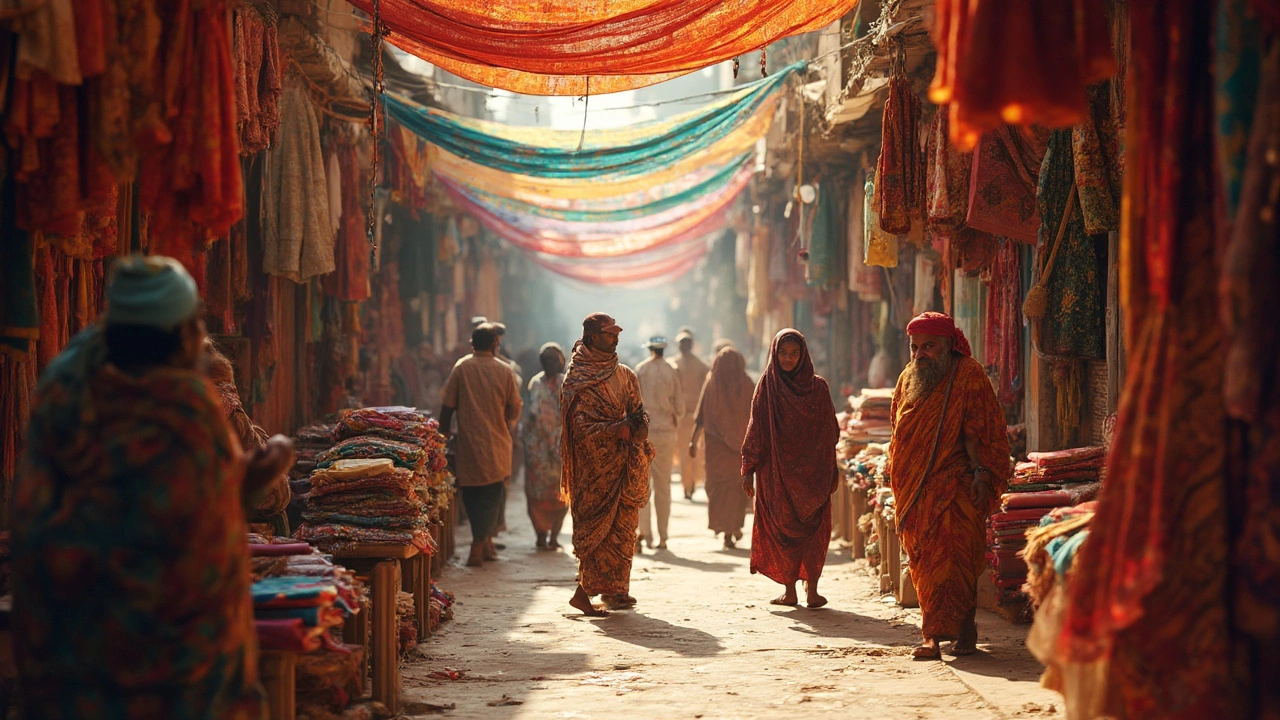When you think about textiles, cities like Manchester or Milan might come to mind. But, here's the twist - India is a powerhouse in the global textile game, often dubbed the 'textile capital of the world.' Surprised? Let’s unravel why.
For centuries, India has been a major player in textiles, with roots that dig deep into history. Talk about tradition, right? Fast forward to today, cities like Surat and Tiruppur are bustling hubs in the industry, pushing the boundaries with both traditional and contemporary designs.
These cities aren't just about charming patterns; they’re economic engines. Textile manufacturing here boosts the economy big time, providing tons of jobs and contributing significantly to the country’s GDP.
- The Historical Edge
- Key Manufacturing Hubs
- Economic Contributions
- Technological Advancements
- Challenges and Solutions
- The Future of Textiles in India
The Historical Edge
When diving into the world of textiles, India's past is a true treasure trove. Did you know that as far back as the Indus Valley Civilization, there were signs of well-developed textile practices? It's like inheriting a textile gold mine! Beyond cultural bragging rights, this robust history laid the groundwork for what’s now the booming textile industry in India.
The Ancient Craft
Before today’s high-tech machinery, Indian artisans were already weaving magic with their hands. From the seventh century onward, the Indian subcontinent was known for its muslin, a lightweight cotton cloth that was highly sought after in ancient Persia and beyond. Talk about being ahead of the curve!
A Colonial Turn
Fast forward to the colonial era, and we see how British control over India’s textile manufacturers seriously impacted the industry. They shipped raw cotton to their own mills, hurting local craft. But this didn't stop Indians; it fueled the Swadeshi movement, which encouraged using domestic goods. It’s a classic story of turning challenges into opportunities.
The Silk Route
If you think about global demand, India's textiles weren't just limited to local shelves, thanks to the Silk Route. This trade network was a highway of sorts for cotton and silk fabrics, making waves globally. Without these routes, today's textile capital status might just be a dream.
India's textiles have been worn by emperors, admired by explorers, and are even depicted in ancient manuscripts. This historical edge isn’t just about past glories; it’s a strong foundation that fuels modern innovations and keeps India at the forefront of global textiles.
Key Manufacturing Hubs
Let's talk about where the magic happens in India's textile industry. If you're diving into the world of textiles, you can't ignore cities like Surat, Tiruppur, and Ludhiana. These cities are pretty much the backbone of textile manufacturing in India.
Surat: The Diamond City That's Also Silk Central
First up, Surat. Known as the Diamond City, it’s also a hotspot for fabric, especially silk and synthetic textiles. Nearly 90% of polyester used in the country comes from Surat! That’s massive, right? The city hosts countless workshops and factories, producing both traditional and modern garments. It's like a fabric factory paradise!
Tiruppur: Knitwear Kingdom
Next, we have Tiruppur, often called the Knitwear Capital of India. If you've bought a comfy t-shirt recently, chances are it was stitched here. The city leads in knitwear exports, with products reaching shelves worldwide. Companies here focus on both quantity and quality. And the best part? They're embracing eco-friendly processes, reducing their carbon footprint one stitch at a time.
| City | Main Contribution | Specialty |
|---|---|---|
| Surat | Textile Manufacturing | Silk, Synthetic Fabrics |
| Tiruppur | Exports | Knitwear |
| Ludhiana | Domestic Supply | Woolen Garments |
Ludhiana: Wool Wonderland
Then there’s Ludhiana, called the Manchester of India, especially known for its production of woolen garments. It’s the go-to place for sweaters, cardigans, and all things cozy. Like the others, it plays a crucial role in keeping India’s textile engine running smoothly.
Each of these hubs has its unique flavor, contributing to why India is seen as a textile capital of the world. They're driving innovation, sustaining livelihoods, and stitching success stories, all while making sure our wardrobes never run dry.
Economic Contributions
Alright, let's get down to the numbers and impact. You wouldn’t believe how significant India's textile industry is when it comes to juicing up the economy. It's a massive deal. We're talking about a sector that contributes around 7% to the industrial output and 2% to the GDP of the country. That's no small potatoes!
Now, why is it such a big player? Well, first off, the industry is a job magnet, employing over 45 million people directly. It’s the second largest employer after agriculture. Imagine the ripple effect of so many people working in textiles—it boosts everything from local businesses to national economic strength.
Let’s not forget about exports. India is one of the top players in textile exports globally. It feeds the world with everything from cotton and wool fabrics to intricate silk sarees. This isn't just about shirts and pants, folks. It's a whole spectrum of products that end up in stores across the globe.
Key Hubs Fueling The Economy
Places like Surat and Tiruppur are often buzzing with activity. Surat, for instance, is known as the 'Silk City' because it produces about 90% of the country’s synthetic textiles. Meanwhile, Tiruppur is the go-to spot for cotton knits—practically the t-shirt capital of India, churning out garments by the truckload.
Tables and charts tell us that as of the latest data, India's textile exports shoot up to over $40 billion annually. Direct numbers like these showcase the sprawling impact of textiles on the country's economic landscape.
Impact Beyond Numbers
But hey, it’s not just numbers and graphs. The textile industry supports rural development, as many of the raw materials—like cotton and jute—are grown by farmers. When you buy that colorful scarf or comfy hoodie, there's a whole chain of livelihoods that you're uplifting.
To sum up, the textile industry in India is not just about creating beautiful items. It is an economic powerhouse driving employment, trade, and development. Whether you're buying locally or internationally, you're part of a profound economic story. It’s amazing how a simple piece of fabric can weave such a complex, impactful narrative.

Technological Advancements
India's textile industry isn't just about tradition; it's equally about innovation. The industry is embracing technology like never before, with advancements that are changing how textile manufacturers operate. Let's dive into some cool tech trends hitting the scene.
Automation in Weaving and Spinning
Automation has well and truly hit the textile world. In both weaving and spinning, robots and automated machines are taking over the mundane tasks once done by hand. These machines work tirelessly, improving efficiency and reducing errors, making sure Indian textiles can keep up with global demands.
Digital Printing
Gone are the days of painstakingly printing each piece by hand. Now, digital printers are ready to print complex designs directly onto fabric with amazing speed and precision. It means endless possibilities for designs and smaller production costs for the companies.
Sustainable Technologies
Let's face it, going green isn't just a fad—it’s the future. Textile tech in India is moving towards more sustainable practices, thanks to water-saving dyes and eco-friendly production processes. Plus, some manufacturers are even using solar power to run their factories. Talk about harnessing the sun in more ways than one!
Smart Textiles
Imagine clothing that can change color with your mood or fabric that monitors your heart rate. Sounds out of a sci-fi movie, right? But it’s happening. The blend of textiles with tech innovations like sensors and conductive threads is bringing 'smart fabrics' to life.
Here's a quick look at some stats on technological adoption in the Indian textile sector:
| Technology | Adoption Rate (%) |
|---|---|
| Automation | 65 |
| Digital Printing | 50 |
| Sustainable Tech | 40 |
| Smart Textiles | 15 |
Pretty cool, right? With these technologies in play, the textile industry in India is all set for an exciting and sustainable future.
Challenges and Solutions
Diving into the textile industry of India, it's not all smooth sailing. Sure, it's a top player, but there are bumps along the way. Let's break down some of these hurdles and how the industry is tackling them.
Environmental Concerns
One biggie? The environmental impact. The industry is notorious for its water consumption and pollution. Dyeing processes often release untreated waste into rivers. Solutions? Many textile manufacturers in India are turning to cleaner technologies. Water recycling systems and eco-friendly dyes are making waves.
Labor Issues
Another challenge is labor conditions. With millions employed, ensuring fair wages and safe working environments is a must. The government and various NGOs are actively working to enforce labor laws, offering training for safer practices as well.
Global Competition
China, Bangladesh, and Vietnam are stiff competitors. But hey, India's got game. By focusing on quality and niche markets, it stays in the race. Customized, high-quality textiles can go head-to-head with mass production.
Technological Adaptation
Adopting new tech isn't easy either. But, using advanced machines and software is essential to keep up. Data analytics for demand forecasting, anyone? Many successful manufacturers are already on it, boosting efficiency and cutting costs.
Table: Key Solutions Embraced by Indian Textile Industry
| Challenge | Solution |
|---|---|
| Environmental Concerns | Eco-friendly dyes, Water recycling |
| Labor Issues | Training programs, Strict enforcement of labor laws |
| Global Competition | Focus on niche markets, Quality enhancement |
| Technological Adaptation | Advanced machinery, Data analytics |
By addressing these issues with these solutions, India’s textile industry isn’t just coping—it's evolving. With every obstacle, there's a chance to innovate and improve.
The Future of Textiles in India
In the ever-changing world of textiles, India is not about to slow down. Far from it! This country's textile industry is gearing up for some exciting advancements and shifts that could shape the market for decades.
Emphasis on Sustainability
More manufacturers are recognizing the importance of going green. The textile scene in India is seeing a surge in sustainable practices. Brands are increasingly opting for organic materials and eco-friendly production methods. Not only is this good for the environment, but it also appeals to consumers who are becoming more eco-conscious.
Technological Innovations
Technology is weaving its way into every thread of India's textile industry. Automation, AI, and IoT are transforming how textiles are produced, making processes faster and more efficient. The impact is big – quicker turnarounds and improved quality control. This tech boost also helps in reducing wastage, which is a win-win for all.
Expanding Global Reach
With the world's eyes on quality textiles, India is expanding its global footprint. The 'Make in India' initiative bolsters local businesses while enhancing exports. More and more international brands are eyeing Indian fabrics, thanks to their reputation for both heritage and innovation.
Challenges Ahead
While the industry is on an upward trajectory, challenges do exist. Compliance with international standards, especially in sustainability, requires continued effort. Moreover, the sector needs skilled workers equipped with modern technical expertise and there’s a push for vocational training programs to meet this demand.
Looking Forward
India's textile future looks promising. With a stride towards innovation and sustainability, it's well poised to maintain its status as a textile capital. Enthusiastic investment and forward-thinking policies can pave the way for a bright textile future in India.
